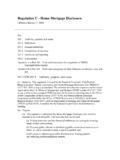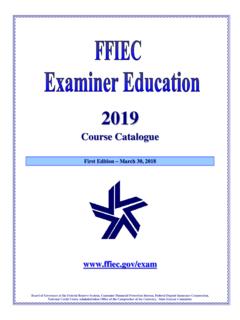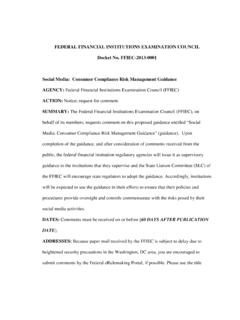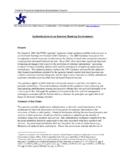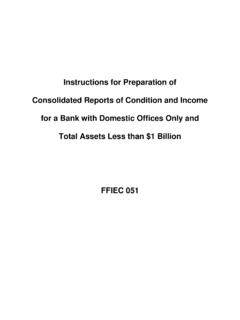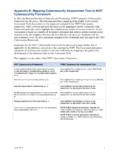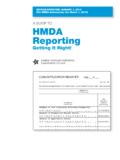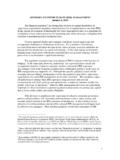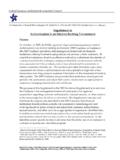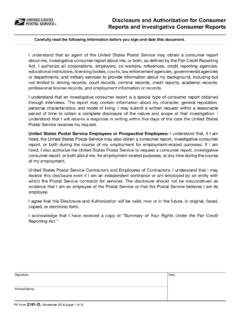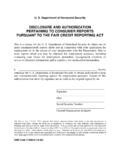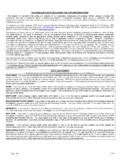Transcription of FFIEC Guidance on Electronic Financial Services and ...
1 federal Financial institutions examination council . Guidance ON Electronic Financial Services . AND consumer COMPLIANCE1. INTRODUCTION. Federally insured depository institutions are developing or employing new Electronic technologies for delivering Financial products to improve customer service and enhance competitive positions. Some of those institutions have asked regulators questions regarding the application of existing consumer protection laws and regulations to Electronic product delivery methods. It is clear from these questions that these institutions are uncertain about the appropriate manner to address Electronic Services under the existing regulatory framework.
2 Accordingly, the Board of Governors of the federal Reserve System, the federal Deposit Insurance Corporation, the National Credit Union Administration, the Office of the Comptroller of the Currency, and the Office of Thrift Supervision (collectively, the Agencies ) are providing federally insured depository institutions with some basic information and suggested Guidance pertaining to federal consumer protection laws and regulations and their application to Electronic Financial service operations. This issuance is intended to assess the implications of some of the emerging Electronic technologies for the consumer regulatory environment, to provide institutions with an overview of pertinent regulatory issues, and to offer suggestions on how to apply existing consumer laws and regulations to new Electronic Financial Services .
3 The term Electronic Financial service as used in this Guidance includes, but is not limited to, on-line Financial Services , Electronic fund transfers, and other Electronic payment systems. On- line Financial Services , stored value card systems, and Electronic cash are among the new Electronic products being introduced in the market. Financial institutions are establishing Internet web sites that advertise products and Services , accept Electronic mail, and provide consumers with the capability to conduct transactions through an on-line system. Services and products can be accessed through personal computers connecting to the institution via proprietary software, commercial on-line Services , and the Internet, or through other access devices including, for example, video kiosks and interactive television.
4 Financial institutions should be advised that many of the general principles, requirements, and controls that apply to paper transactions may also apply to Electronic Financial Services . This Guidance letter contains two sections: 1) The Compliance Regulatory Environment, and 2) The Role of consumer Compliance in Developing and Implementing Electronic Services . Examples relating to compliance issues are used for illustrative purposes; institutions are 1. This document does not serve as an Official Staff Commentary or shield institutions that comply with this Guidance from civil liability for violations under the various statutes addressed. 1.
5 Encouraged to use the concepts underlying these examples when implementing an Electronic Services technology plan. It should be understood that existing consumer laws and regulations generally apply to applicable transactions, advertisements and other Services conducted electronically. It should also be understood, however, that not all of the consumer protection issues that have arisen in connection with new technologies are specifically addressed in this Guidance . Additional communiqu s may be issued in the future to address other aspects of consumer laws and regulations as the Financial service environment evolves. COMPLIANCE REGULATORY ENVIRONMENT.
6 This section summarizes and highlights the most recent changes in the relevant sections of federal consumer protection laws and regulations that address Electronic Financial Services , and notes other relevant provisions of law. This information is not intended to be a complete checklist for consumer compliance in the Electronic medium. It does not address a number of open issues surrounding the application of consumer rules to new Electronic Financial Services that are currently being considered by the appropriate agencies. It is critical that institutions providing Electronic delivery mechanisms develop and maintain an in-depth knowledge of the relevant statutes and regulations.
7 Moreover, it should be kept in mind that additional changes to relevant laws and regulations arising in response to the new Electronic service technologies may occur. The rapid development of technology and new products will require updating of this information. Generally, the regulatory requirement that disclosures be in writing and in a form the customer can keep has been met by providing paper disclosures to the customer. For example, a bank would supplement Electronic disclosures with paper disclosures until the regulations have been reviewed and changed, if necessary, to specifically allow Electronic delivery of disclosures. Some of the consumer regulations were reviewed and changed to reflect Electronic disclosures.
8 These changes are summarized in this section. Also, attached to this Guidance is a matrix entitled Compliance Issues Involving Electronic Services that highlights some of the principal compliance issues that should be considered by Financial institutions when developing and implementing Electronic systems. DEPOSIT Services . Electronic Fund Transfer Act (Regulation E). Generally, when on-line banking systems include Electronic fund transfers that debit or credit a consumer 's account, the requirements of the Electronic Fund Transfer Act and Regulation E apply. A transaction involving stored value products is covered by Regulation E when the transaction accesses a consumer 's account (such as when value is loaded onto the card from the consumer 's deposit account at an Electronic terminal or personal computer).
9 In accordance with , Financial institutions must provide disclosures that are clear and readily understandable, in writing, and in a form the consumer may keep. An Interim rule was 2. issued on March 20, 1998 that allows depository institutions to satisfy the requirement to deliver by Electronic communication any of these disclosures and other information required by the act and regulations, as long as the consumer agrees to such method of delivery. According to the federal Reserve Board Official Staff Commentary (OSC) (a)-4, Financial institutions must ensure that consumers who sign-up for a new banking service are provided with disclosures for the new service if the service is subject to terms and conditions different from those described in the initial disclosures required under Although not specifically mentioned in the commentary, this applies to all new banking Services including Electronic Financial Services .
10 The OSC also clarifies that terminal receipts are unnecessary for transfers initiated on-line. Specifically, OSC (h)-1 provides that, because the term Electronic terminal excludes a telephone operated by a consumer , Financial institutions need not provide a terminal receipt when a consumer initiates a transfer by a means analogous in function to a telephone, such as by a personal computer or a facsimile machine. Additionally, OSC (b)-5 clarifies that a written authorization for preauthorized transfers from a consumer 's account includes an Electronic authorization that is not signed, but similarly authenticated by the consumer , such as through the use of a security code.
